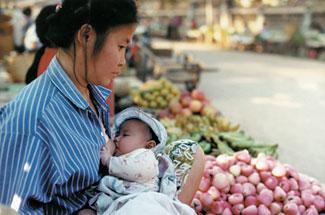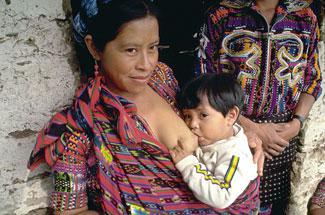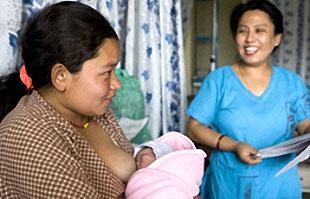Why does any discussion of breastfeeding makes people a little insane? I don’t exclude myself: even I get a little agitated. Here are some examples of what I mean:
Exhibit A: a recent post on breastfeeding at KevinMD.com sparked a small flame war in the comments. Barbara Bronson, an RN wrote there:

A mother breastfeeds as she tends her produce market stall. (Source: WHO)
And guess what? Our kids — now in their twentie [sic] – turned out just fine. They have no allergies. They are smart. They’re not fat. They’re healthy. They are kind, and funny and athletic, and you couldn’t pick them out in a crowd. But if you read some of the research and most of the women’s magazines, you’d think we’d be hauled in for heresy for disclosing this seldom-talking-about fact: in the end, whether you breast-feed or you bottle-feed, no one — not even a physician, a nurse, a teacher or a psychologist – will ever be able to tell the difference.
[SNIP]
So that’s why I was pleased to see the World Health Organization announce that although they recommend breastfeeding for the first six months of life, they say it may not be a realistic option for many. The report was published online March 14, 2012 in the BMJ Open.
The curious thing about this particular post is that it almost completely misrepresents the British Medical Journal article cited above. The BMJ article suggests an idealistic public policy approach to breastfeeding may be counterproductive — and only dealt with new mothers in a developed country. Bronson’s post managed to turn this important study into a disavowal of the World Health Organization’s breastfeeding guidelines. Of course, it said no such thing. (A far more accurate take on the BMJ article can be found on the Breastfeeding Medicine blog. Or just read the damn thing.) Not that is matters much: the debate degenerates into bomb-throwing between pro-formula-you-lactivists-are-Nazis and breast-is-best types. Who cares about the science, anyway — it just gets in the way of anecdotes and feelings.
(Yes, I am annoyed.)
Exhibit B: a city ordinance in Seattle protecting the rights of neonates to breastfeed publicly causes distress for those who prefer breastfeeding mothers to be unseen and unheard:
“We need to get to the point where breastfeeding is accepted by everybody,” said Schwartz of the Breastfeeding Coalition. Although businesses that break the law can face fines, she said the main goal was to educate people and change attitudes.
“It’s feeding your baby for heaven’s sake,” she said.
But advocates will have to overcome an ingrained hostility, as seen oozing in the comments on a KING/5′s story on the breastfeeding bill.
“Wanna feed your kid, great feed your kid, just don’t put up a bill board (sic) pointing to your saggy udders trying to get some attention,” wrote “freedomfrank” on the site.
“As far as I’m concerned, women with babies can get the (hell) out of any restaurant I’m in if they want to breast feed,” another commenter wrote. “You’re not special and we don’t give a rip that you have a baby.”
One woman wrote that she supported breastfeeding – had nursed her own kids – but just didn’t like it in public.
“I do not want to watch you when I am trying to eat or walking in the mall with my teen son,” she said.

A toddler breastfeeds while sitting on his mother's lap. (Source: WHO)
(The measure passed.)
Exhibit C: suffer not the little children unto me. Rachel Stone writes:
When he was one year old and decidedly cherubic—with chubby pink cheeks and golden curls—my family visited Rome, and, of course, Vatican City. I was prepared with skirts and modest tops for visiting St. Peter’s, but I hadn’t considered for a moment that breastfeeding might break the rules of modesty. So when my little cherub was hungry, I settled cross-legged in a corner, in sight of Michelangelo’s Pieta—that haunting sculpture where Mary cradles the broken body of her Son—and began to nurse, identifying, maybe for the first time, with Jesus’ mom as I cradled by own boy.
Seconds later, a uniformed guard came along, slapping his chest and saying, emphatically, “Latte, latte!? Latte? Uh, downstair! Uh, da batroom!” Of course: he wanted me to go breastfeed in the bathroom. Because nursing my son in that space was equivalent to a plunging neckline or a miniskirt.
All of this makes me a little crazy for the sheer stupidity. However, I get there is some deep cultural resistance antipathy to breastfeeding in the West and particularly in North America. I happen to think this ambiguity — where Facebook bans pictures of breastfeeding but permits hypersexualized pictures of busty women — is utterly idiotic and tied up in some bizarre societal notions about breasts and sexuality, but I understand that others’ mileage may vary.

(Source: WHO)
I get that nurses, midwives and other healthcare providers haven’t been the best at times supporting and encouraging new mothers to breastfeed. We nag, hector and finger-wag when we should be providing support and empathy.
But still, for all of that, breastfeeding is undoubtedly the best choice for most women and neonates. Yes, there are exceptions: neonates who can’t or won’t nurse, or physical, health or social/economic problems preventing the mother from nursing. But really, are theses exceptions so numerous to recommend formula as the equivalent choice for all neonates? To use an analogy, gold standard treatment for pneumonia is the prescription of antibiotics. Does the standard change because a few might not tolerate the drugs? It bothers me more than a little the nurse mentioned above would suggest bottle and breast are equivalent, whatever her own personal experience.
Something else which makes me unhappy: how the debate around breastfeeding is almost always framed from the perspective of middle-class women from developed countries like the U.S, Canada or Britain who have the resources to consider formula as a viable option. For most of the world’s women, the sheer logistics of bottle feeding are not feasible or realistic. These include consistent access clean water, soap, a stove, fuel, education, and nurse/midwife support, the formula itself and other supplies, or the money to buy it. According to the World Health Organization:
When infant formula is not properly prepared, there are some risks arising from the use of unsafe water and unsterilized equipment or the potential presence of bacteria in powdered formula. Malnutrition can result from over-diluting formula to “stretch” supplies. Further, frequent feedings maintain the breast milk supply. If formula is used but becomes unavailable, a return to breastfeeding may not be an option due to diminished breast milk production.
For many, if not the majority of women in the world, and especially the poorest, there is no option but breastfeeding. We should probably bear this in mind when discussing how “realistic” the WHO guidelines are.
